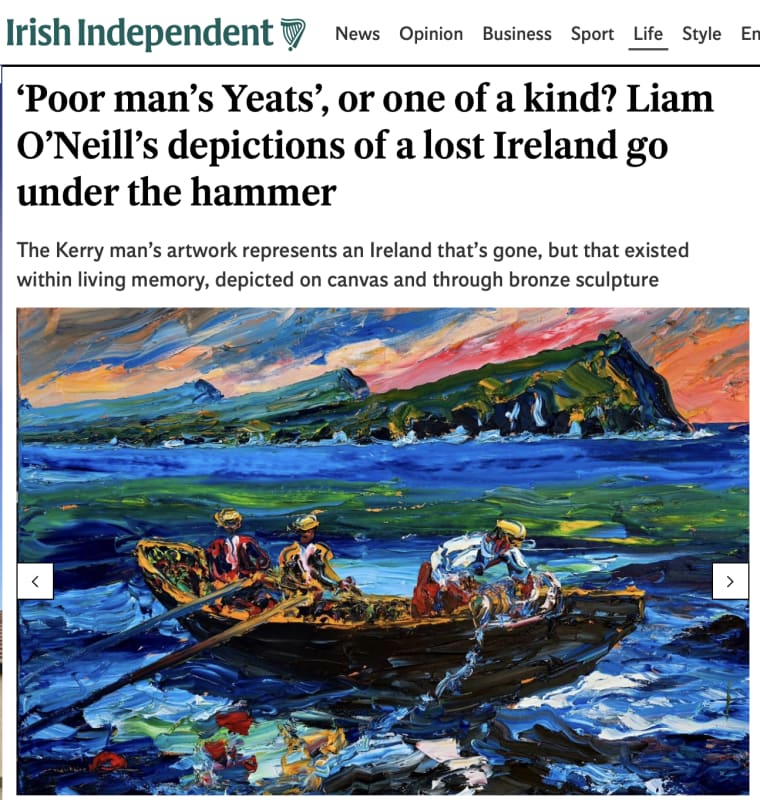‘Poor man’s Yeats’, or one of a kind? Liam O’Neill’s depictions of a lost Ireland go under the hammer
When Liam O’Neill started school, he walked there in his bare feet. Born in 1954, the artist comes from Corca Dhuibhne, Co Kerry. His paintings – and a new series of sculptures – come from his memories of his father at work: cutting turf on the mountain, pulling lobster pots by hand, and harvesting oats with a scythe.
“Someone once said that Liam O’Neill paints his father in every painting,” he says. “But he also paints everybody’s father.”
This universality is part of their appeal. O’Neill’s paintings represent an Ireland that’s gone, but that existed within living memory. They speak to those who remember, or wish they remembered, a way of life so recently lost.
“The world has changed a lot since then,” O’Neill says. “But for generations before that, it hadn’t changed at all.”
O’Neill’s new sculpture collection in bronze (from €18,000 to €44,000) and a selection of his paintings (from €10,500 to €39,500) are on view at an event hosted by Gormleys at Sheen Falls Lodge, Kenmare, until October 12.
The exhibition includes works by Andy Warhol, Salvador Dali and Patrick Rubinstein. “He’s very collectable,” says Oliver Gormley. “A lot of Americans buy his work, and his paintings hold their value.”
The sculptures are too new for Gormley to predict their trajectory on the secondary market. “I know the paintings will go up in price but, with the sculptures, it’s too early to say. People are buying them because they’re Liam O’Neill but they’re not market proven.”
To date, O’Neill’s auction record is held by Whyte’s. His painting, Two Horses, went under the hammer in March 2023 with an estimate of €5,000 to €7,000. It sold for €35,000.

Naomhóg Capall na Farraige by Liam O'Neill
The horses are painted in O’Neill’s distinctive, semi-abstract style, with thick impasto applied with a palette knife. They appeal to those who’d love, but cannot afford, a horse painting by Jack B Yeats. “O’Neill has been described as a poor man’s Jack B Yeats,” Gormley says. “I don’t know if that’s fair or unfair.”
The comparison isn’t fair on either artist. There was only one Jack B Yeats, whose work is unequalled. O’Neill is doing his own thing, informed by his west Kerry heritage.
Yeats came from relative privilege: art college education and a family of writers and artists. O’Neill did not.
O’Neill is a self-taught artist, but this was not intentional. “I wanted to be an architect and I passed the exams to study in Bolton Street, but then my father died and we couldn’t afford the fees,” he says.
O’Neill trained as a special needs teacher and taught in north Dublin for 20 years, but he also made and exhibited paintings.
“They say the best way of learning how to do things is to make mistakes,” he reflects. “But there are things I wish I’d been told 50 years ago!”

Cutting Mountain Turf by Liam O'Neill at Gormleys
He recalls a professor from NCAD who used to come to his exhibitions. O’Neill once told him that he’d love to study at the art college. “If I was you, I’d stay away from us,” the professor advised. “We’d knock it out of you.”
Like his paintings, O’Neill’s bronze sculptures have a strong narrative thread. Naomhóg Capall na Farraige, 28x60x33 cm (€26,000) shows three fishermen in a naomhóg – a traditional west Kerry boat – on a choppy sea.
Two are rowing, one is tending a lobster pot. It’s closely observed, but also informed by experience. In the 1970s, O’Neill was tending the lobster pots with his cousin when they caught a blue lobster.
“We fished in a naomhóg each summer,” he says. “We’d always start out before dawn. I was the one pulling the pots. Our line would be marked with a red buoy, and the pots would be pulled by hand – five pots on 20 fathoms of rope – and this magical thing comes up out of the water. It was glowing!”
Most lobsters are mottled brown. There’s a one in two-million chance of catching a blue lobster (the colouring is caused by a genetic mutation). There’s also a superstition attached. “A blue lobster supposedly gives you the best of luck,” O’Neill says. “But only if you throw it back in the sea.”
In real life, the blue lobster was released. In the sculpture, it’s ambiguous. The boat is threatened by an approaching wave. “There’s another tradition about the seventh wave. If it hits the naomhóg on the side, you’re a gonner!”

